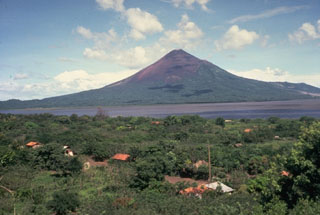Report on Momotombo (Nicaragua) — October 1993
Bulletin of the Global Volcanism Network, vol. 18, no. 10 (October 1993)
Managing Editor: Edward Venzke.
Momotombo (Nicaragua) Fumarolic activity continues to decrease
Please cite this report as:
Global Volcanism Program, 1993. Report on Momotombo (Nicaragua) (Venzke, E., ed.). Bulletin of the Global Volcanism Network, 18:10. Smithsonian Institution. https://doi.org/10.5479/si.GVP.BGVN199310-344090
Momotombo
Nicaragua
12.423°N, 86.539°W; summit elev. 1270 m
All times are local (unless otherwise noted)
A crater inspection on the night of 27 October revealed a decrease in the fumarolic activity observed since August. Temperatures had declined at all measured locations in the three main fumarolic areas. The maximum temperature recorded was 562°C, a decrease of 33° since late September. Some small fissures with very weak incandescence were observed in the most active zone in the W crater wall. The maximum temperature was estimated at 580°C, based on the level of incandescence at measured locations.
Fumarole temperatures increased between 1976 and 1986, reaching >900°C in August 1986. Temperatures were in the 870-885°C range from January 1985 through April 1986 (SEAN 10:11 and 11:05). Similar temperatures were measured in March and April 1989 (SEAN 14:02 and 14:04), but had decreased 50-150°C by April 1990 (BGVN 15:04). Temperatures have now returned to the level observed in 1977.
Geological Summary. Momotombo is a young stratovolcano that rises prominently above the NW shore of Lake Managua, forming one of Nicaragua's most familiar landmarks. Momotombo began growing about 4500 years ago at the SE end of the Marrabios Range and consists of a somma from an older edifice that is surmounted by a symmetrical younger cone with a 150 x 250 m wide summit crater. Young lava flows extend down the NW flank into the 4-km-wide Monte Galán caldera. The youthful cone of Momotombito forms an island offshore in Lake Managua. Momotombo has a long record of Strombolian eruptions, punctuated by occasional stronger explosive activity. The latest eruption, in 1905, produced a lava flow that traveled from the summit to the lower NE base. A small black plume was seen above the crater after a 10 April 1996 earthquake, but later observations noted no significant changes in the crater. A major geothermal field is located on the south flank.
Information Contacts: Alain Creusot, Instituto Nicaraguense de Energía, Managua, Nicaragua.

